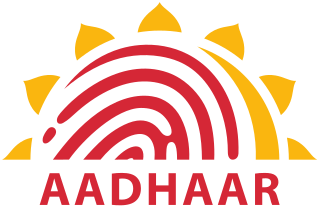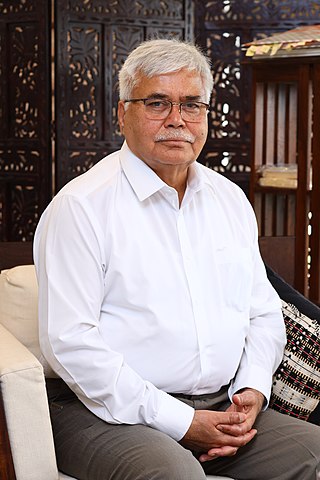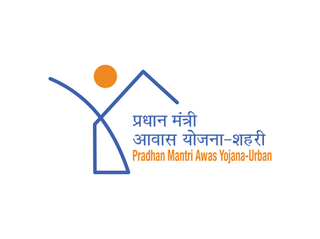Related Research Articles
Social security in India includes a variety of statutory insurances and social grant schemes bundled into a formerly complex and fragmented system run by the Indian government at the federal and the state level. The Directive Principles of State Policy, enshrined in Part IV of the Indian Constitution reflects that India is a welfare state. Food security to all Indians are guaranteed under the National Food Security Act, 2013 where the government provides highly subsidised food grains or a food security allowance to economically vulnerable people. The system has since been universalised with the passing of The Code on Social Security, 2020. These cover most of the Indian population with social protection in various situations in their lives.

Aadhaar is a 12-digit unique identity number that can be obtained voluntarily by all residents of India, based on their biometrics and demographic data. The data is collected by the Unique Identification Authority of India (UIDAI), a statutory authority established in January 2009 by the Government of India, under the jurisdiction of the Ministry of Electronics and Information Technology, following the provisions of the Aadhaar Act, 2016.

Ram Sewak Sharma is an Indian bureaucrat and former civil servant. From February 2021, he is serving as the Chief Executive Officer of the National Health Authority, an Indian governmental organisation tasked with managing public health insurance till February 2023. Previously, he has headed the Telecom Regulatory Authority of India, and the Unique Identification Authority of India.

Pradhan Mantri Gramin Aawas Yojana, previously Indira Awas Yojana, is a social welfare programme, created by the Indian Government, to provide housing for the rural poor in India. A similar scheme for urban poor was launched in 2015 as Housing for All by 2022. Indira Awas Yojana was launched in 1985 by Rajiv Gandhi, the Prime Minister of India, as one of the major flagship programs of the Ministry of Rural Development to construct houses for the Below Poverty Line population in the villages.

Agriculture in India is highly susceptible to risks like droughts and floods. It is necessary to protect the farmers from natural calamities and ensure their credit eligibility for the next season. For this purpose, the Government of India introduced many agricultural social insurances throughout the country, the most important one of them being Pradhan Mantri Fasal Bima Yojana.
Direct Benefit Transfer or DBT is an attempt to change the mechanism of transferring subsidies launched by Government of India on 1 January 2013. This scheme or program aims to establish a Giro system to transfer subsidies directly to the people through their linked bank accounts. It is hoped that crediting subsidies into bank accounts will reduce leakages, duplicity and delay and the new processes will increase transparency and accountability.

Ration cards are an official document issued by state governments in India to households that are eligible to purchase subsidised food grain from the Public Distribution System under the National Food Security Act (NFSA). They also serve as a common form of identification for many Indians.

Pradhan Mantri Jan Dhan Yojana is a financial inclusion program of the Government of India open to Indian citizens, that aims to expand affordable access to financial services such as bank accounts, remittances, credit, insurance and pensions. This financial inclusion campaign was launched by the Prime Minister of India Narendra Modi on 28 August 2014. He had announced this scheme on his first Independence Day speech on 15 August 2014.

Digital India is a campaign launched by the Government of India to make its services available to citizens electronically via improved online infrastructure and by increasing Internet connectivity. The initiative includes plans to connect rural areas with high-speed internet networks. It consists of three core components: the development of secure and stable digital infrastructure, delivering government services digitally, and universal digital literacy.
Pradhan Mantri Suraksha Bima Yojana is a government-backed accident insurance scheme in India. It was originally mentioned in the 2015 Budget speech by Finance Minister Late Arun Jaitley in February 2015. It was formally launched by the Prime Minister Narendra Modi on 8 May in Kolkata.
Pradhan Mantri Jeevan Jyoti Bima Yojana is a Government-backed Life insurance scheme in India. It was originally mentioned in the year 2015 Budget speech by the then-Finance Minister, late Arun Jaitley in February 2015. It was formally launched by Prime Minister Narendra Modi on 9 May in Kolkata. As of May 2015, only 20% of India's population has any kind of insurance, this scheme aims to increase the number.

Atal Pension Yojana, formerly known as Swavalamban Yojana is a government-backed pension scheme in India, primarily targeted at the unorganised sector. It was mentioned in the year 2015 Budget speech by the Finance Minister Arun Jaitley. It was launched by Prime Minister Narendra Modi on 9 May 2015 in Kolkata.

Pradhan Mantri Awas Yojana (PMAY) is a credit-linked subsidy scheme by the Government of India to facilitate access to affordable housing for the low and moderate-income residents of the country. It envisaged a target of building 2 crore (20 million) affordable houses by 31 March 2022. It has two components: Pradhan Mantri Awas Yojana(Urban) (PMAY-U) for the urban poor and Pradhan Mantri Awaas Yojana (Gramin) (PMAY-G and also PMAY-R) for the rural poor, the former administered by Ministry of Housing and Urban Affairs and the latter by Ministry of Rural Development. This scheme converges with other schemes to ensure that houses have a toilet, Saubhagya Scheme for universal electricity connection, Ujjwala Yojana LPG connection, access to drinking water and Jan Dhan banking facilities, etc.
Pradhan Mantri Krishi Sinchai Yojana is a national mission to improve farm productivity and ensure better utilization of the resources in the country. The budget of ₹53 billion (US$660 million) in a time span of one year 2015-2016 has been allocated to this scheme. The decision was taken on 1 July 2015 at the meeting of Cabinet Committee on Economic Affairs, approved with an outlay of 50000 crore for period of 5 years.

The Aadhaar Act, 2016 is a money bill of the Parliament of India. It aims to provide legal backing to the Aadhaar unique identification number project. It was passed on 11 March 2016 by the Lok Sabha. Certain provisions of the Act came into force from 12 July 2016 and 12 September 2016.
Give Up LPG Subsidy is a campaign that was launched in March 2015 by the Indian government led by Prime Minister Narendra Modi. It is aimed at motivating LPG users who are able to afford to pay the market price for LPG to voluntarily surrender their LPG subsidy. As of 23 April 2016, 10 million people had voluntarily given up the subsidy. The surrendered subsidy is being redistributed by the government in order to provide cooking gas connections to poor families in rural households free of cost. Maharashtra, Uttar Pradesh, Karnataka, Delhi and Tamil Nadu are the top five states to give up the subsidy.

Pradhan Mantri Ujjwala Yojana was launched by Prime Minister of India Narendra Modi on 1 May 2016 to distribute 50 million LPG connections to women of Below Poverty Line (BPL) families. A budgetary allocation of ₹80 billion (US$1.0 billion) was made for the scheme. The scheme was replaced by the Ujjwala Yojana 2.0 in 2021.

Airtel Payments Bank is an Indian payments bank with its headquarters in New Delhi. The company is a subsidiary of Bharti Airtel. On 5 January 2022, it was granted the scheduled bank status by Reserve Bank of India under second schedule of RBI Act, 1934.
Pradhan Mantri Garib Kalyan Anna Yojana is a food security welfare scheme announced by the Government of India on March 26 2020, during the COVID-19 pandemic in India. The program is operated by the Department of Food and Public Distribution under the Ministry of Consumer Affairs, Food and Public Distribution. But the nodal ministry is Ministry of Finance.The scale of this welfare scheme makes it the largest food security program in the world benefiting 81.35 crore in India.
References
- ↑ "India has started linking Jan Dhan scheme, Aadhaar and mobile numbers: Arun Jaitley", Live Mint , 2 April 2016
- ↑ Prime Minister to Launch Pradhan Mantri Jan Dhan Yojana Tomorrow, Press Information Bureau, Govt. of India, 27 August 2014
- ↑ ET Bureau (28 August 2014), PM 'Jan Dhan' Yojana launched; aims to open 1.5 crore bank accounts on first day, The Economic Times
- ↑ "Modi: Banking for all to end "financial untouchability"". Reuters. 28 August 2014.
- ↑ "Pradhan Mantri Jan-Dhan Yojana", pmjdy.gov.in, archived from the original on 21 November 2015, retrieved 31 August 2016
- ↑ "Unique Identification project expenditure at Rs 3,062 crore as of July end". The Economic Times . 29 August 2013. Retrieved 29 May 2015.
- ↑ "Learning with the Times: What is Aadhaar?". The Times of India . 4 December 2010. Retrieved 29 May 2015.
- ↑ Chin, Roger (June 2015). "India's Aadhaar Project: The Unprecedented and Unique Partnership for Inclusion" (PDF). Journal of Administrative Science.[ permanent dead link ]
- ↑ "UIDAI: Inside the World's Largest Data Management Project". Forbes (India). 29 November 2010. Retrieved 26 May 2015.
- ↑ "Aadhaar world's largest biometric ID system". The Times of India . 27 April 2015. Retrieved 31 May 2015.
- ↑ "National Identification Authority of India Bill, 2010". PRS Legislative Research.
- ↑ "Aadhaar legislation tabled as a money Bill". The Hindu Business Line . 3 March 2016.
- ↑ "Aadhaar bill passed in Lok Sabha". Live Mint . 11 March 2016. Retrieved 11 March 2016.
- ↑ "Archived copy" (PDF). Archived from the original (PDF) on 16 August 2016. Retrieved 31 August 2016.
{{cite web}}: CS1 maint: archived copy as title (link) - ↑ "UID an assault on individual liberty: Activists". Rediff . 6 September 2010. Retrieved 29 May 2015.
- ↑ "AADHAR: Union Cabinet of Ignorance!". Rediff . Retrieved 29 May 2015.
- ↑ "The Trouble With Big Brother's Eye". Tehelka . 31 August 2012. Archived from the original on 22 June 2015. Retrieved 29 May 2015.
- ↑ "Nine issues to debate on Aadhaar Bill". The Hindu. 11 March 2016. ISSN 0971-751X . Retrieved 28 June 2016.
- ↑ "Don't tie up benefits to Aadhaar, court tells Centre". The Hindu . 24 September 2013. Retrieved 27 May 2015.
- ↑ "Aadhaar Card Not Mandatory, Supreme Court Rules". NDTV . 11 August 2015. Retrieved 6 September 2015.
- ↑ "Aadhaar shall remain optional: Supreme Court". The Hindu . 11 August 2015. Retrieved 6 September 2015.
- ↑ "SC rules Aadhaar card not mandatory, says government cannot share any personal information". IBNLive . 11 August 2015. Retrieved 6 September 2015.
- ↑ Staff Writer (26 September 2018). "What Supreme Court's Aadhaar verdict means for you: 10 points". mint. Retrieved 7 February 2022.